power steering BMW M3 COUPE 2008 E92 Owner's Manual
[x] Cancel search | Manufacturer: BMW, Model Year: 2008, Model line: M3 COUPE, Model: BMW M3 COUPE 2008 E92Pages: 172, PDF Size: 5.29 MB
Page 53 of 172
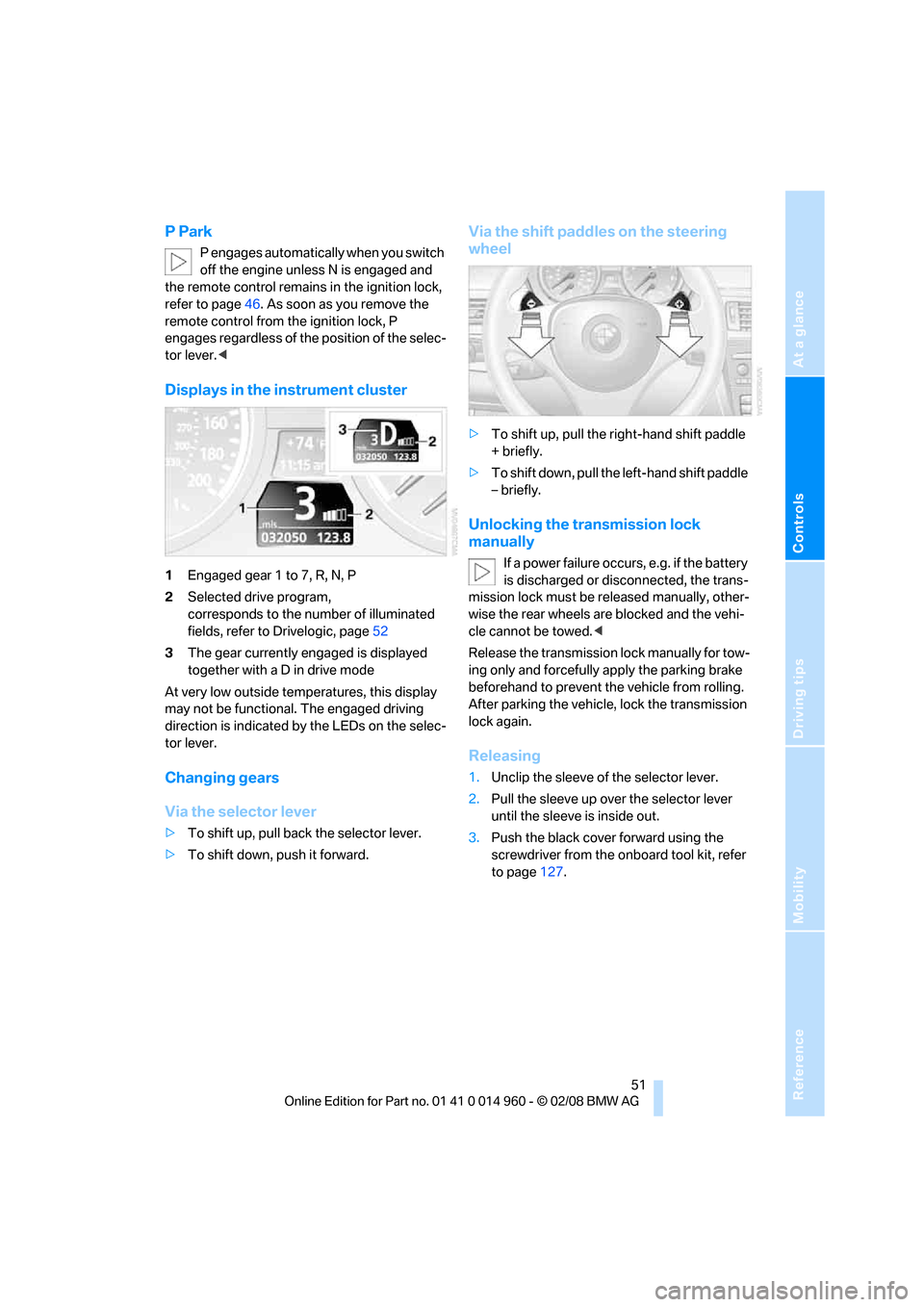
Reference
At a glance
Controls
Driving tips
Mobility
51
P Park
P engages automatically when you switch
off the engine unless N is engaged and
the remote control remains in the ignition lock,
refer to page46. As soon as you remove the
remote control from the ignition lock, P
engages regardless of the position of the selec-
tor lever.<
Displays in the instrument cluster
1Engaged gear 1 to 7, R, N, P
2Selected drive program,
corresponds to the number of illuminated
fields, refer to Drivelogic, page52
3The gear currently engaged is displayed
together with a D in drive mode
At very low outside temperatures, this display
may not be functional. The engaged driving
direction is indicated by the LEDs on the selec-
tor lever.
Changing gears
Via the selector lever
>To shift up, pull back the selector lever.
>To shift down, push it forward.
Via the shift paddles on the steering
wheel
>To shift up, pull the right-hand shift paddle
+ briefly.
>To shift down, pull the left-hand shift paddle
– briefly.
Unlocking the transmission lock
manually
If a power failure occurs, e.g. if the battery
is discharged or disconnected, the trans-
mission lock must be released manually, other-
wise the rear wheels are blocked and the vehi-
cle cannot be towed.<
Release the transmission lock manually for tow-
ing only and forcefully apply the parking brake
beforehand to prevent the vehicle from rolling.
After parking the vehicle, lock the transmission
lock again.
Releasing
1.Unclip the sleeve of the selector lever.
2.Pull the sleeve up over the selector lever
until the sleeve is inside out.
3.Push the black cover forward using the
screwdriver from the onboard tool kit, refer
to page127.
Page 59 of 172
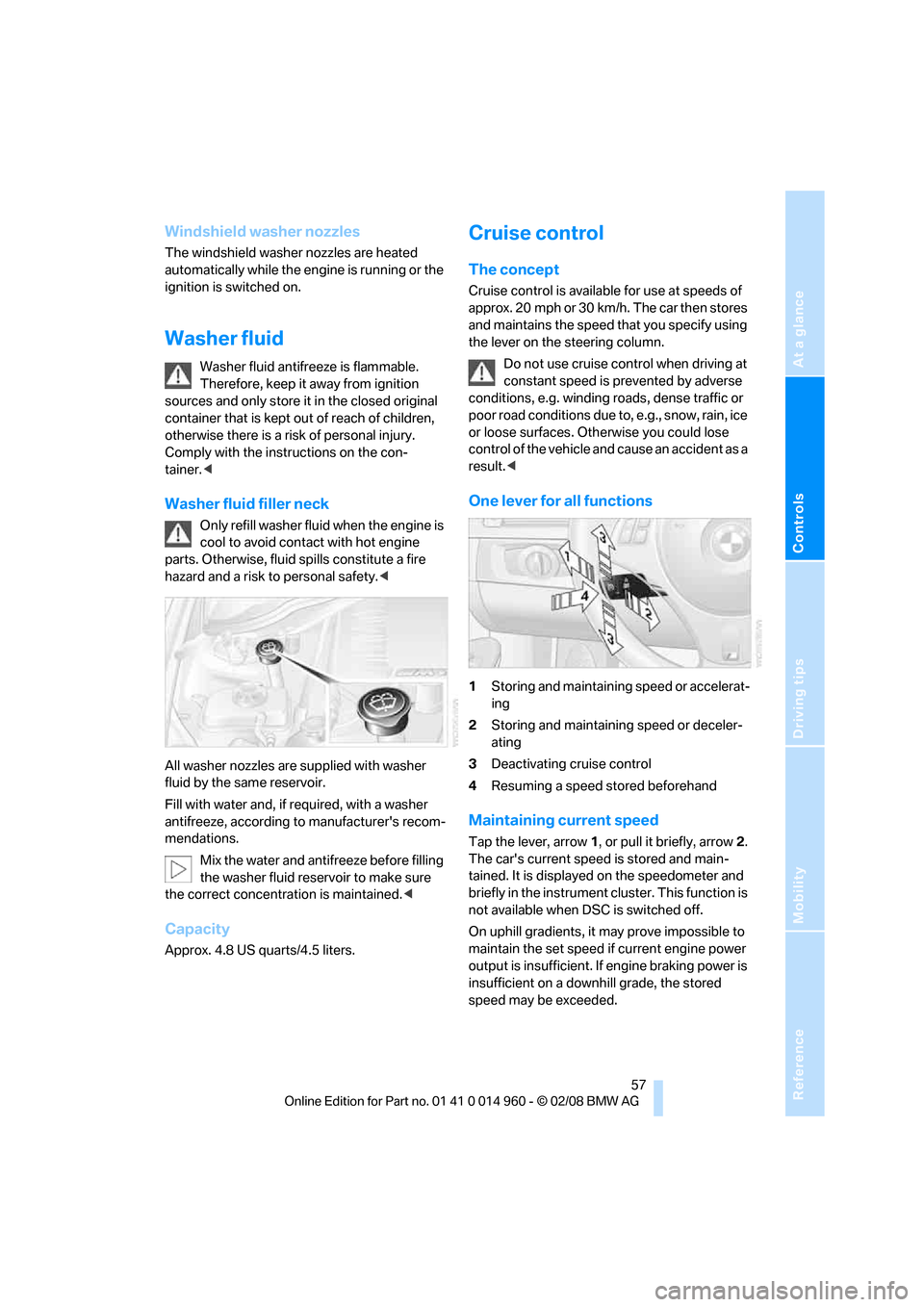
Reference
At a glance
Controls
Driving tips
Mobility
57
Windshield washer nozzles
The windshield washer nozzles are heated
automatically while the engine is running or the
ignition is switched on.
Washer fluid
Washer fluid antifreeze is flammable.
Therefore, keep it away from ignition
sources and only store it in the closed original
container that is kept out of reach of children,
otherwise there is a risk of personal injury.
Comply with the instructions on the con-
tainer.<
Washer fluid filler neck
Only refill washer fluid when the engine is
cool to avoid contact with hot engine
parts. Otherwise, fluid spills constitute a fire
hazard and a risk to personal safety.<
All washer nozzles are supplied with washer
fluid by the same reservoir.
Fill with water and, if required, with a washer
antifreeze, according to manufacturer's recom-
mendations.
Mix the water and antifreeze before filling
the washer fluid reservoir to make sure
the correct concentration is maintained.<
Capacity
Approx. 4.8USquarts/4.5liters.
Cruise control
The concept
Cruise control is available for use at speeds of
approx. 20 mph or 30 km/h. The car then stores
and maintains the speed that you specify using
the lever on the steering column.
Do not use cruise control when driving at
constant speed is prevented by adverse
conditions, e.g. winding roads, dense traffic or
poor road conditions due to, e.g., snow, rain, ice
or loose surfaces. Otherwise you could lose
control of the vehicle and cause an accident as a
result.<
One lever for all functions
1Storing and maintaining speed or accelerat-
ing
2Storing and maintaining speed or deceler-
ating
3Deactivating cruise control
4Resuming a speed stored beforehand
Maintaining current speed
Tap the lever, arrow 1, or pull it briefly, arrow 2.
The car's current speed is stored and main-
tained. It is displayed on the speedometer and
briefly in the instrument cluster. This function is
not available when DSC is switched off.
On uphill gradients, it may prove impossible to
maintain the set speed if current engine power
output is insufficient. If engine braking power is
insufficient on a downhill grade, the stored
speed may be exceeded.
Page 70 of 172
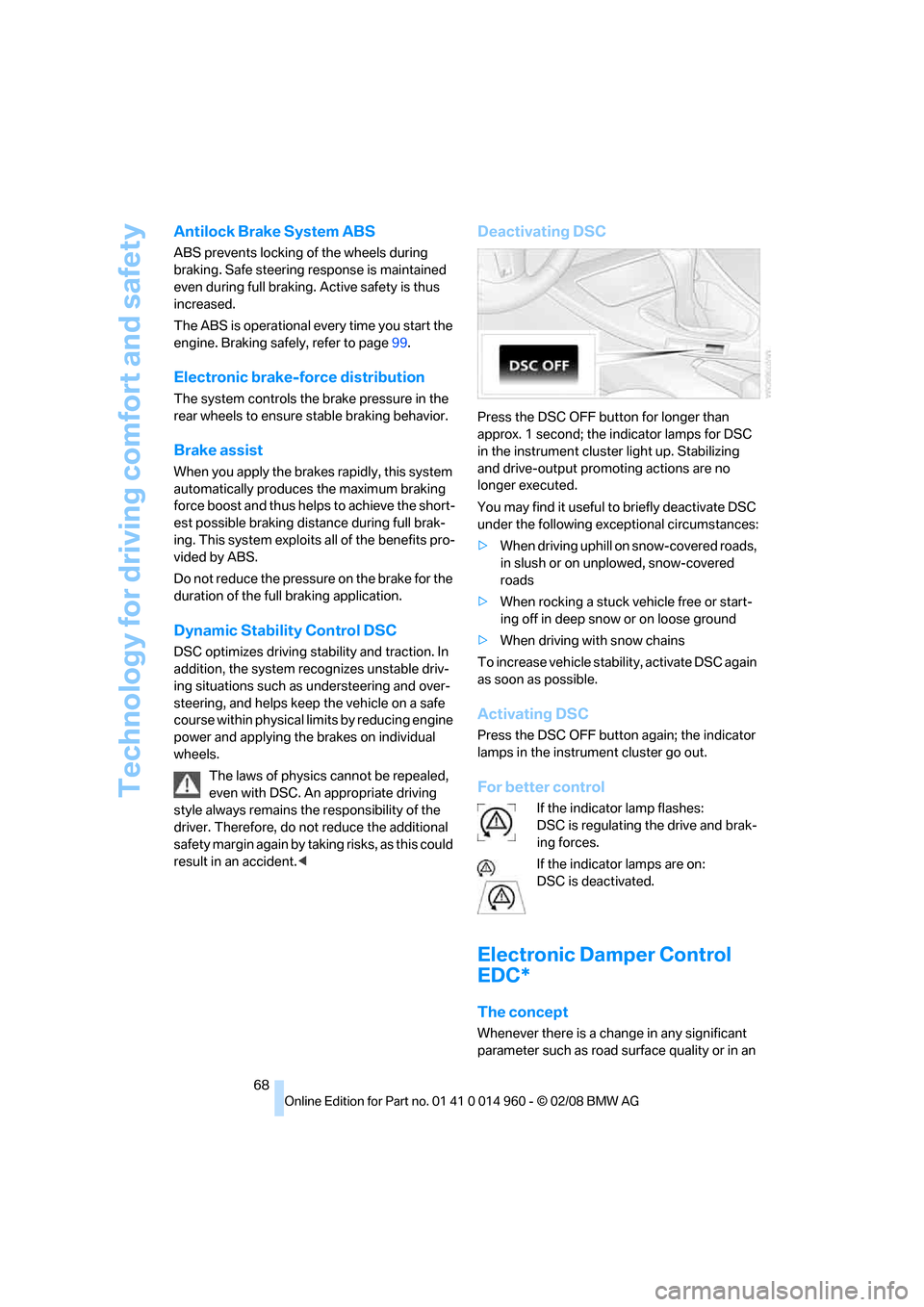
Technology for driving comfort and safety
68
Antilock Brake System ABS
ABS prevents locking of the wheels during
braking. Safe steering response is maintained
even during full braking. Active safety is thus
increased.
The ABS is operational every time you start the
engine. Braking safely, refer to page99.
Electronic brake-force distribution
The system controls the brake pressure in the
rear wheels to ensure stable braking behavior.
Brake assist
When you apply the brakes rapidly, this system
automatically produces the maximum braking
force boost and thus helps to achieve the short-
est possible braking distance during full brak-
ing. This system exploits all of the benefits pro-
vided by ABS.
Do not reduce the pressure on the brake for the
duration of the full braking application.
Dynamic Stability Control DSC
DSC optimizes driving stability and traction. In
addition, the system recognizes unstable driv-
ing situations such as understeering and over-
steering, and helps keep the vehicle on a safe
course within physical limits by reducing engine
power and applying the brakes on individual
wheels.
The laws of physics cannot be repealed,
even with DSC. An appropriate driving
style always remains the responsibility of the
driver. Therefore, do not reduce the additional
safety margin again by taking risks, as this could
result in an accident.<
Deactivating DSC
Press the DSC OFF button for longer than
approx. 1 second; the indicator lamps for DSC
in the instrument cluster light up. Stabilizing
and drive-output promoting actions are no
longer executed.
You may find it useful to briefly deactivate DSC
under the following exceptional circumstances:
>When driving uphill on snow-covered roads,
in slush or on unplowed, snow-covered
roads
>When rocking a stuck vehicle free or start-
ing off in deep snow or on loose ground
>When driving with snow chains
To increase vehicle stability, activate DSC again
as soon as possible.
Activating DSC
Press the DSC OFF button again; the indicator
lamps in the instrument cluster go out.
For better control
If the indicator lamp flashes:
DSC is regulating the drive and brak-
ing forces.
If the indicator lamps are on:
DSC is deactivated.
Electronic Damper Control
EDC*
The concept
Whenever there is a change in any significant
parameter such as road surface quality or in an
Page 79 of 172
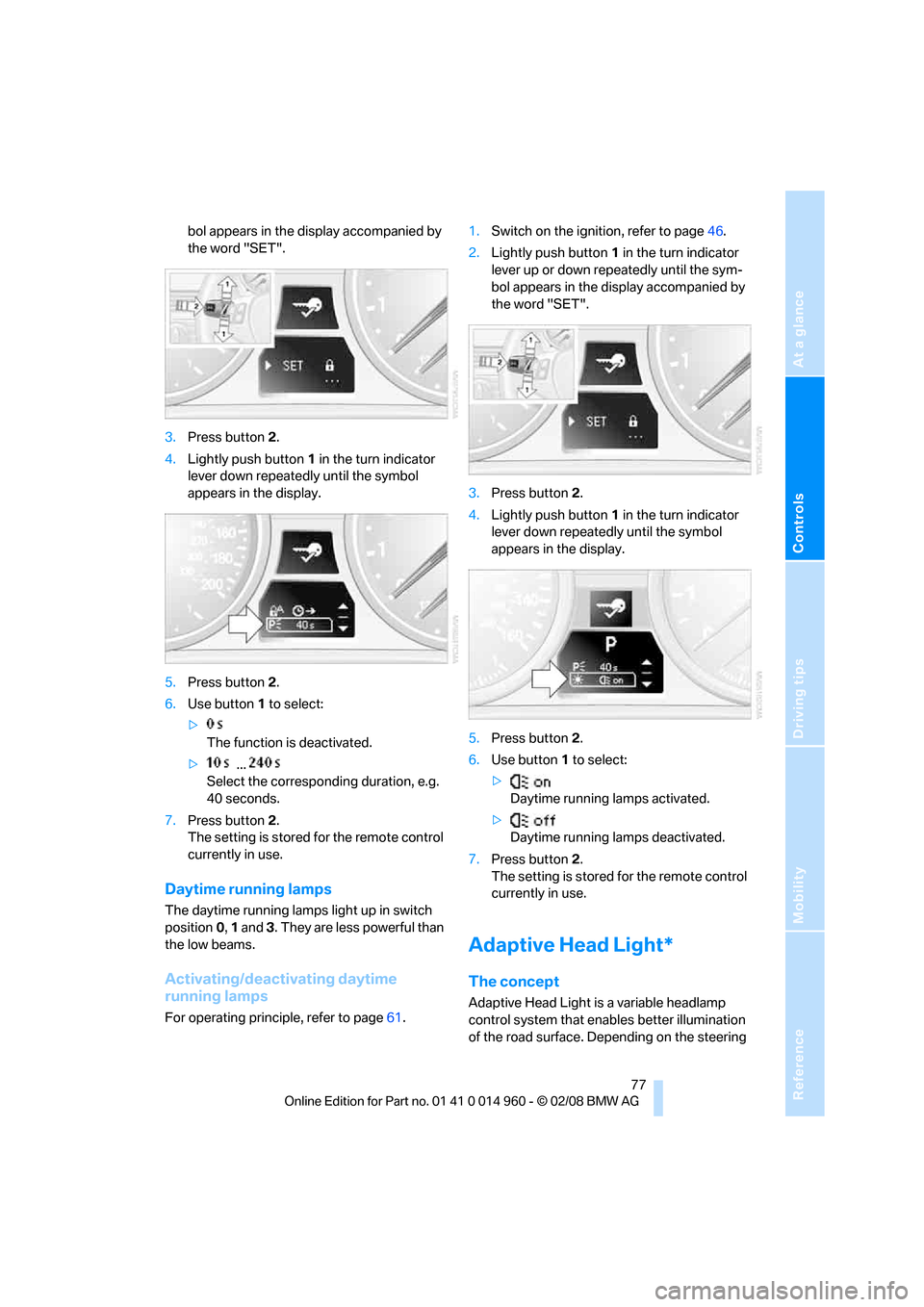
Reference
At a glance
Controls
Driving tips
Mobility
77
bol appears in the display accompanied by
the word "SET".
3.Press button 2.
4.Lightly push button1 in the turn indicator
lever down repeatedly until the symbol
appears in the display.
5.Press button 2.
6.Use button 1 to select:
>
The function is deactivated.
> ...
Select the corresponding duration, e.g.
40 seconds.
7.Press button 2.
The setting is stored for the remote control
currently in use.
Daytime running lamps
The daytime running lamps light up in switch
position0, 1 and 3. They are less powerful than
the low beams.
Activating/deactivating daytime
running lamps
For operating principle, refer to page61.1.Switch on the ignition, refer to page46.
2.Lightly push button1 in the turn indicator
lever up or down repeatedly until the sym-
bol appears in the display accompanied by
the word "SET".
3.Press button 2.
4.Lightly push button1 in the turn indicator
lever down repeatedly until the symbol
appears in the display.
5.Press button 2.
6.Use button 1 to select:
>
Daytime running lamps activated.
>
Daytime running lamps deactivated.
7.Press button 2.
The setting is stored for the remote control
currently in use.
Adaptive Head Light*
The concept
Adaptive Head Light is a variable headlamp
control system that enables better illumination
of the road surface. Depending on the steering
Page 80 of 172
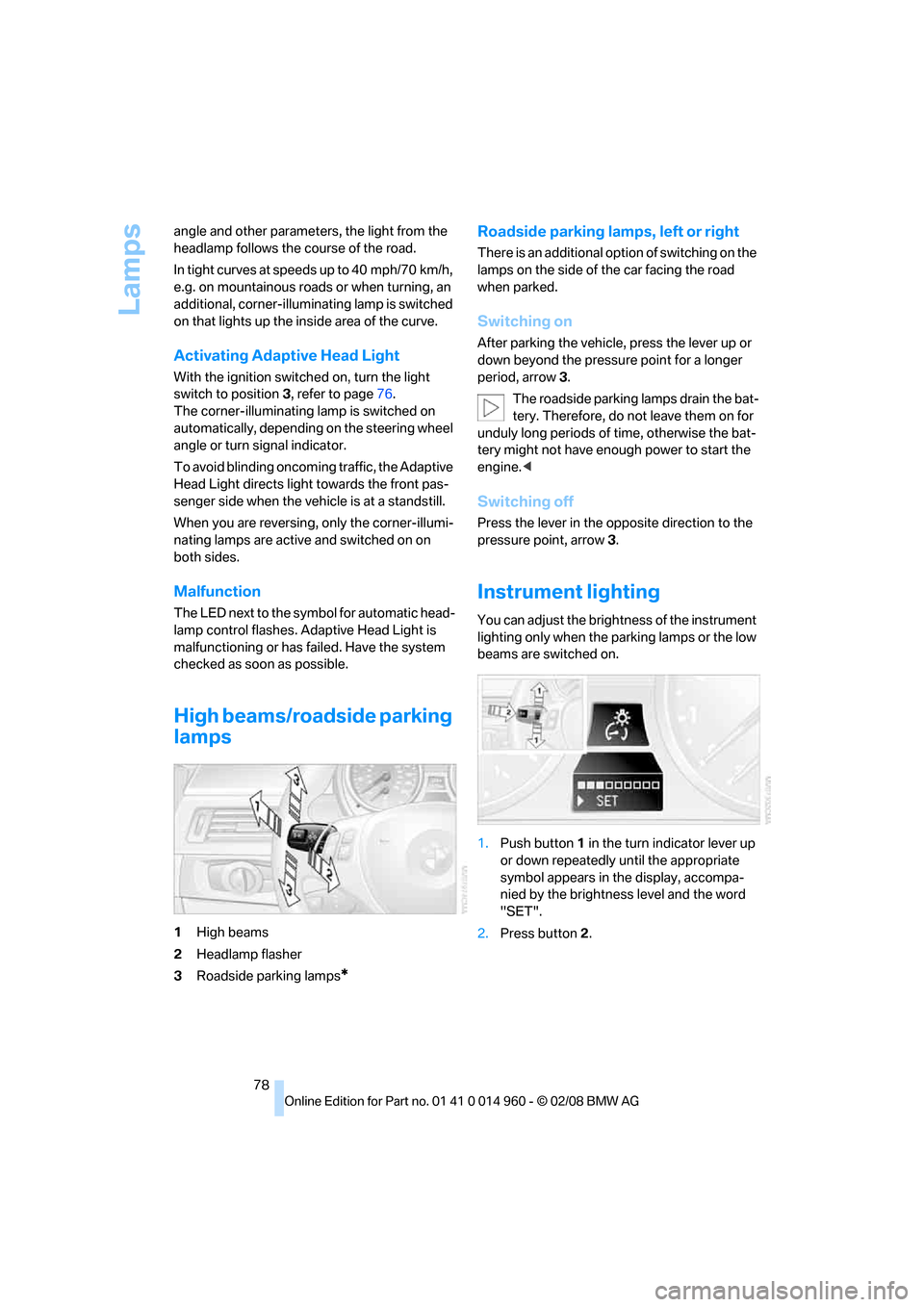
Lamps
78 angle and other parameters, the light from the
headlamp follows the course of the road.
In tight curves at speeds up to 40 mph/70 km/h,
e.g. on mountainous roads or when turning, an
additional, corner-illuminating lamp is switched
on that lights up the inside area of the curve.
Activating Adaptive Head Light
With the ignition switched on, turn the light
switch to position 3, refer to page76.
The corner-illuminating lamp is switched on
automatically, depending on the steering wheel
angle or turn signal indicator.
To avoid blinding oncoming traffic, the Adaptive
Head Light directs light towards the front pas-
senger side when the vehicle is at a standstill.
When you are reversing, only the corner-illumi-
nating lamps are active and switched on on
both sides.
Malfunction
The LED next to the symbol for automatic head-
lamp control flashes. Adaptive Head Light is
malfunctioning or has failed. Have the system
checked as soon as possible.
High beams/roadside parking
lamps
1High beams
2Headlamp flasher
3Roadside parking lamps
*
Roadside parking lamps, left or right
There is an additional option of switching on the
lamps on the side of the car facing the road
when parked.
Switching on
After parking the vehicle, press the lever up or
down beyond the pressure point for a longer
period, arrow 3.
The roadside parking lamps drain the bat-
tery. Therefore, do not leave them on for
unduly long periods of time, otherwise the bat-
tery might not have enough power to start the
engine.<
Switching off
Press the lever in the opposite direction to the
pressure point, arrow 3.
Instrument lighting
You can adjust the brightness of the instrument
lighting only when the parking lamps or the low
beams are switched on.
1.Push button 1 in the turn indicator lever up
or down repeatedly until the appropriate
symbol appears in the display, accompa-
nied by the brightness level and the word
"SET".
2.Press button 2.
Page 89 of 172
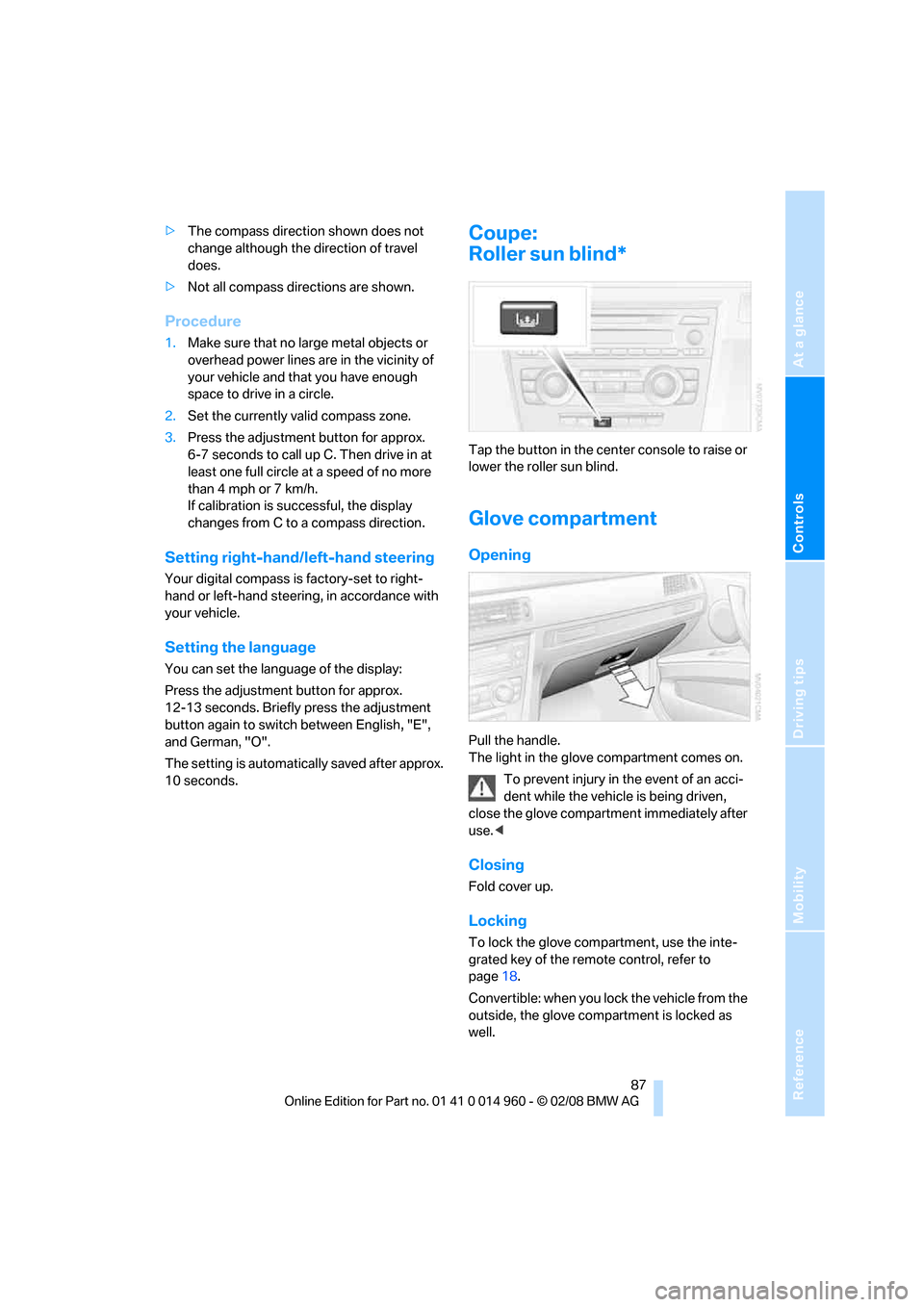
Reference
At a glance
Controls
Driving tips
Mobility
87
>The compass direction shown does not
change although the direction of travel
does.
>Not all compass directions are shown.
Procedure
1.Make sure that no large metal objects or
overhead power lines are in the vicinity of
your vehicle and that you have enough
space to drive in a circle.
2.Set the currently valid compass zone.
3.Press the adjustment button for approx.
6-7 seconds to call up C. Then drive in at
least one full circle at a speed of no more
than 4 mph or 7 km/h.
If calibration is successful, the display
changes from C to a compass direction.
Setting right-hand/left-hand steering
Your digital compass is factory-set to right-
hand or left-hand steering, in accordance with
your vehicle.
Setting the language
You can set the language of the display:
Press the adjustment button for approx.
12-13 seconds. Briefly press the adjustment
button again to switch between English, "E",
and German, "O".
The setting is automatically saved after approx.
10 seconds.
Coupe:
Roller sun blind*
Tap the button in the center console to raise or
lower the roller sun blind.
Glove compartment
Opening
Pull the handle.
The light in the glove compartment comes on.
To prevent injury in the event of an acci-
dent while the vehicle is being driven,
close the glove compartment immediately after
use.<
Closing
Fold cover up.
Locking
To lock the glove compartment, use the inte-
grated key of the remote control, refer to
page18.
Convertible: when you lock the vehicle from the
outside, the glove compartment is locked as
well.
Page 101 of 172
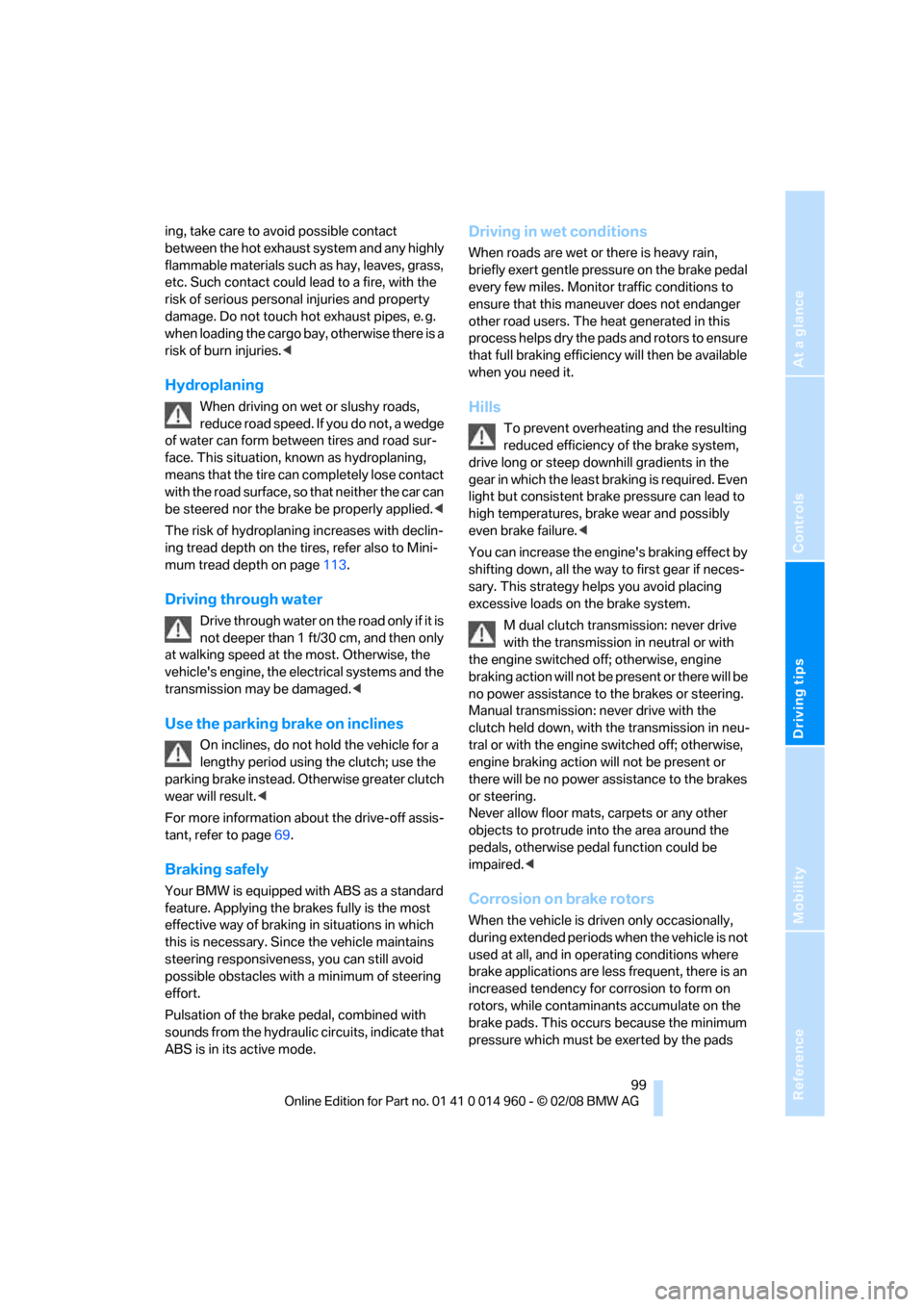
Reference
At a glance
Controls
Driving tips
Mobility
99
ing, take care to avoid possible contact
between the hot exhaust system and any highly
flammable materials such as hay, leaves, grass,
etc. Such contact could lead to a fire, with the
risk of serious personal injuries and property
damage. Do not touch hot exhaust pipes, e. g.
when loading the cargo bay, otherwise there is a
risk of burn injuries.<
Hydroplaning
When driving on wet or slushy roads,
reduce road speed. If you do not, a wedge
of water can form between tires and road sur-
face. This situation, known as hydroplaning,
means that the tire can completely lose contact
with the road surface, so that neither the car can
be steered nor the brake be properly applied.<
The risk of hydroplaning increases with declin-
ing tread depth on the tires, refer also to Mini-
mum tread depth on page113.
Driving through water
Drive through water on the road only if it is
not deeper than 1 ft/30 cm, and then only
at walking speed at the most. Otherwise, the
vehicle's engine, the electrical systems and the
transmission may be damaged.<
Use the parking brake on inclines
On inclines, do not hold the vehicle for a
lengthy period using the clutch; use the
parking brake instead. Otherwise greater clutch
wear will result.<
For more information about the drive-off assis-
tant, refer to page69.
Braking safely
Your BMW is equipped with ABS as a standard
feature. Applying the brakes fully is the most
effective way of braking in situations in which
this is necessary. Since the vehicle maintains
steering responsiveness, you can still avoid
possible obstacles with a minimum of steering
effort.
Pulsation of the brake pedal, combined with
sounds from the hydraulic circuits, indicate that
ABS is in its active mode.
Driving in wet conditions
When roads are wet or there is heavy rain,
briefly exert gentle pressure on the brake pedal
every few miles. Monitor traffic conditions to
ensure that this maneuver does not endanger
other road users. The heat generated in this
process helps dry the pads and rotors to ensure
that full braking efficiency will then be available
when you need it.
Hills
To prevent overheating and the resulting
reduced efficiency of the brake system,
drive long or steep downhill gradients in the
gear in which the least braking is required. Even
light but consistent brake pressure can lead to
high temperatures, brake wear and possibly
even brake failure.<
You can increase the engine's braking effect by
shifting down, all the way to first gear if neces-
sary. This strategy helps you avoid placing
excessive loads on the brake system.
M dual clutch transmission: never drive
with the transmission in neutral or with
the engine switched off; otherwise, engine
braking action will not be present or there will be
no power assistance to the brakes or steering.
Manual transmission: never drive with the
clutch held down, with the transmission in neu-
tral or with the engine switched off; otherwise,
engine braking action will not be present or
there will be no power assistance to the brakes
or steering.
Never allow floor mats, carpets or any other
objects to protrude into the area around the
pedals, otherwise pedal function could be
impaired.<
Corrosion on brake rotors
When the vehicle is driven only occasionally,
during extended periods when the vehicle is not
used at all, and in operating conditions where
brake applications are less frequent, there is an
increased tendency for corrosion to form on
rotors, while contaminants accumulate on the
brake pads. This occurs because the minimum
pressure which must be exerted by the pads
Page 140 of 172
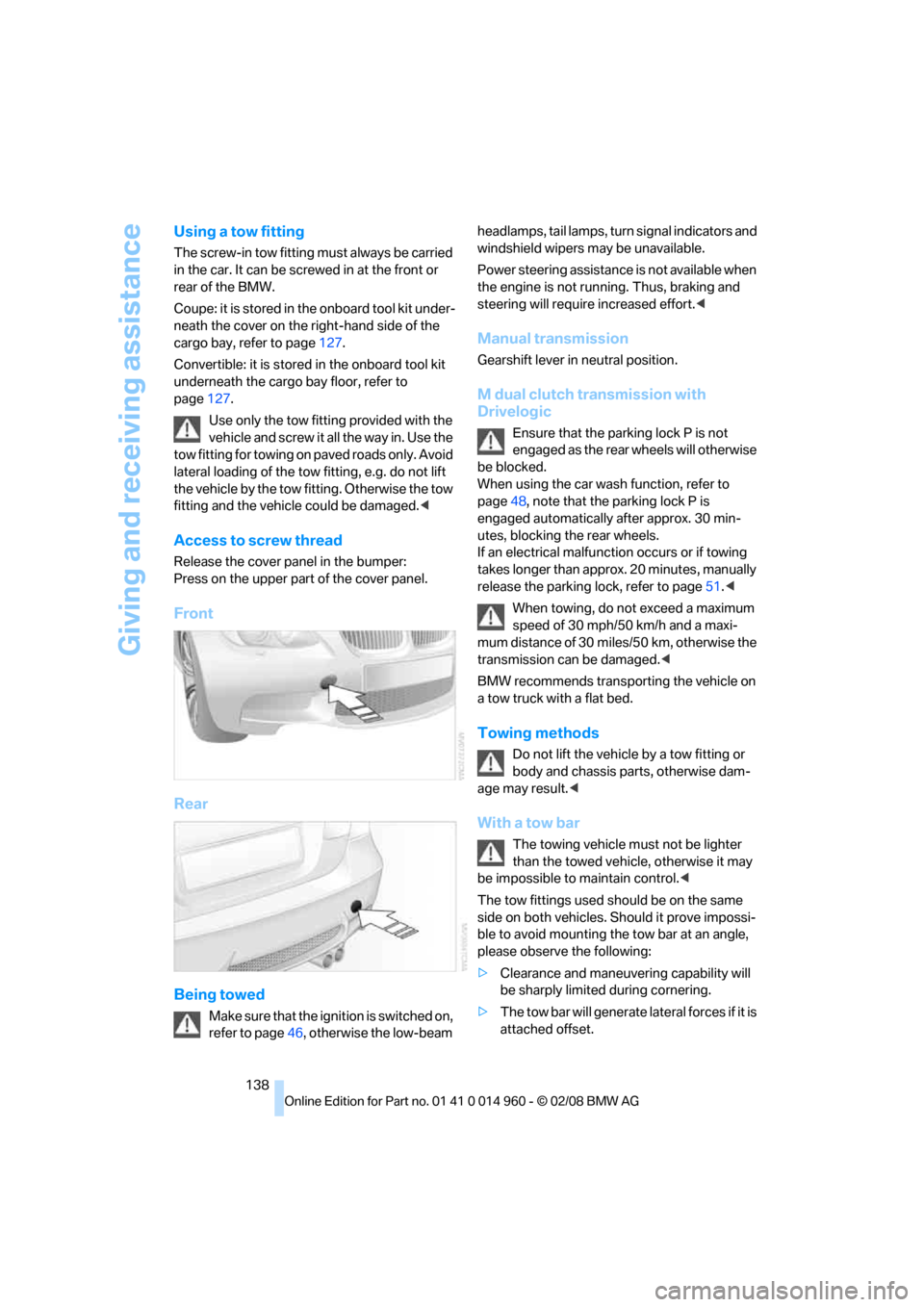
Giving and receiving assistance
138
Using a tow fitting
The screw-in tow fitting must always be carried
in the car. It can be screwed in at the front or
rear of the BMW.
Coupe: it is stored in the onboard tool kit under-
neath the cover on the right-hand side of the
cargo bay, refer to page127.
Convertible: it is stored in the onboard tool kit
underneath the cargo bay floor, refer to
page127.
Use only the tow fitting provided with the
vehicle and screw it all the way in. Use the
tow fitting for towing on paved roads only. Avoid
lateral loading of the tow fitting, e.g. do not lift
the vehicle by the tow fitting. Otherwise the tow
fitting and the vehicle could be damaged.<
Access to screw thread
Release the cover panel in the bumper:
Press on the upper part of the cover panel.
Front
Rear
Being towed
Make sure that the ignition is switched on,
refer to page46, otherwise the low-beam headlamps, tail lamps, turn signal indicators and
windshield wipers may be unavailable.
Power steering assistance is not available when
the engine is not running. Thus, braking and
steering will require increased effort.<
Manual transmission
Gearshift lever in neutral position.
M dual clutch transmission with
Drivelogic
Ensure that the parking lock P is not
engaged as the rear wheels will otherwise
be blocked.
When using the car wash function, refer to
page48, note that the parking lock P is
engaged automatically after approx. 30 min-
utes, blocking the rear wheels.
If an electrical malfunction occurs or if towing
takes longer than approx. 20 minutes, manually
release the parking lock, refer to page51.<
When towing, do not exceed a maximum
speed of 30 mph/50 km/h and a maxi-
mum distance of 30 miles/50 km, otherwise the
transmission can be damaged.<
BMW recommends transporting the vehicle on
a tow truck with a flat bed.
Towing methods
Do not lift the vehicle by a tow fitting or
body and chassis parts, otherwise dam-
age may result.<
With a tow bar
The towing vehicle must not be lighter
than the towed vehicle, otherwise it may
be impossible to maintain control.<
The tow fittings used should be on the same
side on both vehicles. Should it prove impossi-
ble to avoid mounting the tow bar at an angle,
please observe the following:
>Clearance and maneuvering capability will
be sharply limited during cornering.
>The tow bar will generate lateral forces if it is
attached offset.
Page 162 of 172
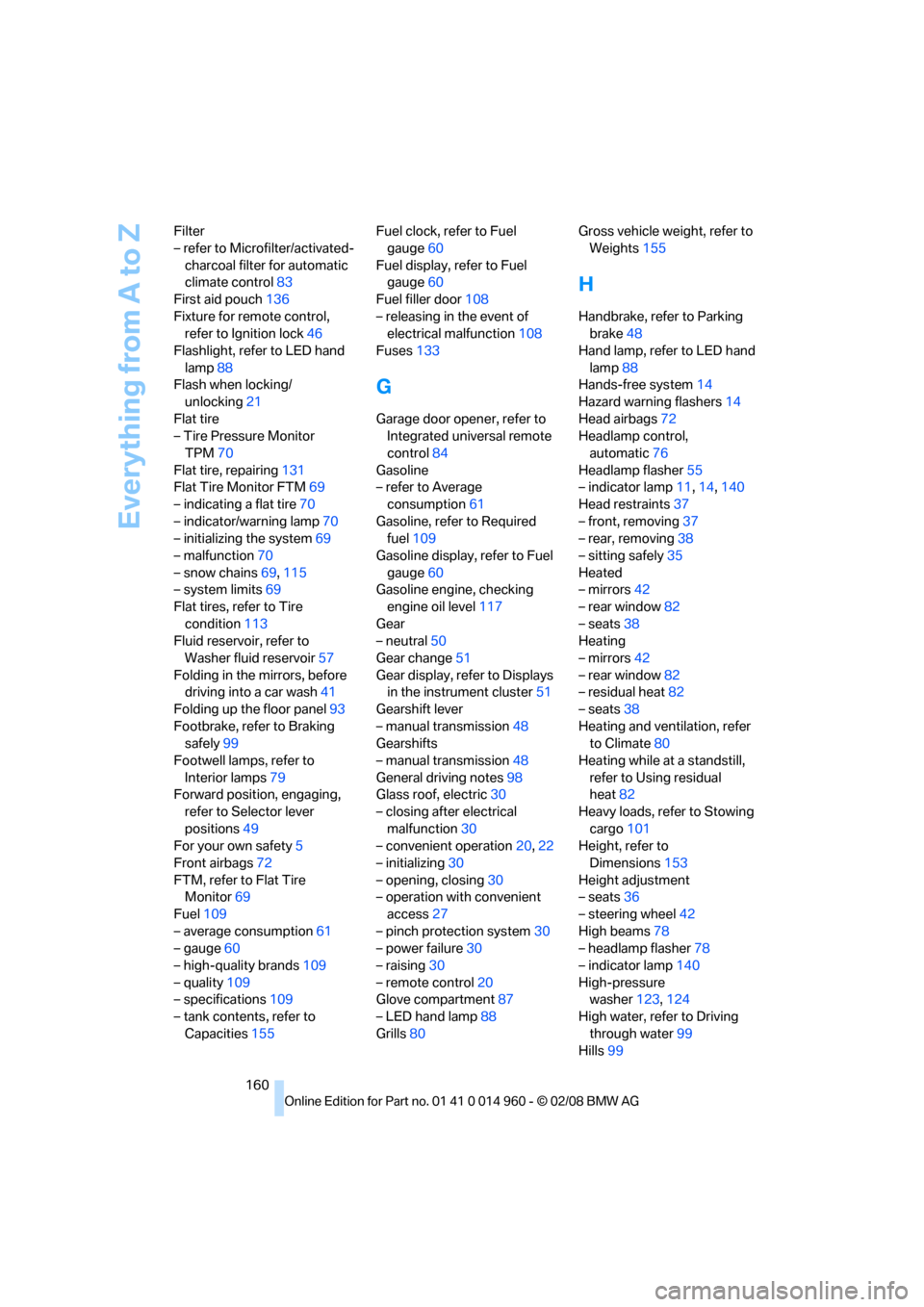
Everything from A to Z
160 Filter
– refer to Microfilter/activated-
charcoal filter for automatic
climate control83
First aid pouch136
Fixture for remote control,
refer to Ignition lock46
Flashlight, refer to LED hand
lamp88
Flash when locking/
unlocking21
Flat tire
– Tire Pressure Monitor
TPM70
Flat tire, repairing131
Flat Tire Monitor FTM69
– indicating a flat tire70
– indicator/warning lamp70
– initializing the system69
– malfunction70
– snow chains69,115
– system limits69
Flat tires, refer to Tire
condition113
Fluid reservoir, refer to
Washer fluid reservoir57
Folding in the mirrors, before
driving into a car wash41
Folding up the floor panel93
Footbrake, refer to Braking
safely99
Footwell lamps, refer to
Interior lamps79
Forward position, engaging,
refer to Selector lever
positions49
For your own safety5
Front airbags72
FTM, refer to Flat Tire
Monitor69
Fuel109
– average consumption61
– gauge60
– high-quality brands109
– quality109
– specifications109
– tank contents, refer to
Capacities155Fuel clock, refer to Fuel
gauge60
Fuel display, refer to Fuel
gauge60
Fuel filler door108
– releasing in the event of
electrical malfunction108
Fuses133
G
Garage door opener, refer to
Integrated universal remote
control84
Gasoline
– refer to Average
consumption61
Gasoline, refer to Required
fuel109
Gasoline display, refer to Fuel
gauge60
Gasoline engine, checking
engine oil level117
Gear
– neutral50
Gear change51
Gear display, refer to Displays
in the instrument cluster51
Gearshift lever
– manual transmission48
Gearshifts
– manual transmission48
General driving notes98
Glass roof, electric30
– closing after electrical
malfunction30
– convenient operation20,22
– initializing30
– opening, closing30
– operation with convenient
access27
– pinch protection system30
– power failure30
– raising30
– remote control20
Glove compartment87
– LED hand lamp88
Grills80Gross vehicle weight, refer to
Weights155
H
Handbrake, refer to Parking
brake48
Hand lamp, refer to LED hand
lamp88
Hands-free system14
Hazard warning flashers14
Head airbags72
Headlamp control,
automatic76
Headlamp flasher55
– indicator lamp11,14,140
Head restraints37
– front, removing37
– rear, removing38
– sitting safely35
Heated
– mirrors42
– rear window82
– seats38
Heating
– mirrors42
– rear window82
– residual heat82
– seats38
Heating and ventilation, refer
to Climate80
Heating while at a standstill,
refer to Using residual
heat82
Heavy loads, refer to Stowing
cargo101
Height, refer to
Dimensions153
Height adjustment
– seats36
– steering wheel42
High beams78
– headlamp flasher78
– indicator lamp140
High-pressure
washer123,124
High water, refer to Driving
through water99
Hills99
Page 165 of 172
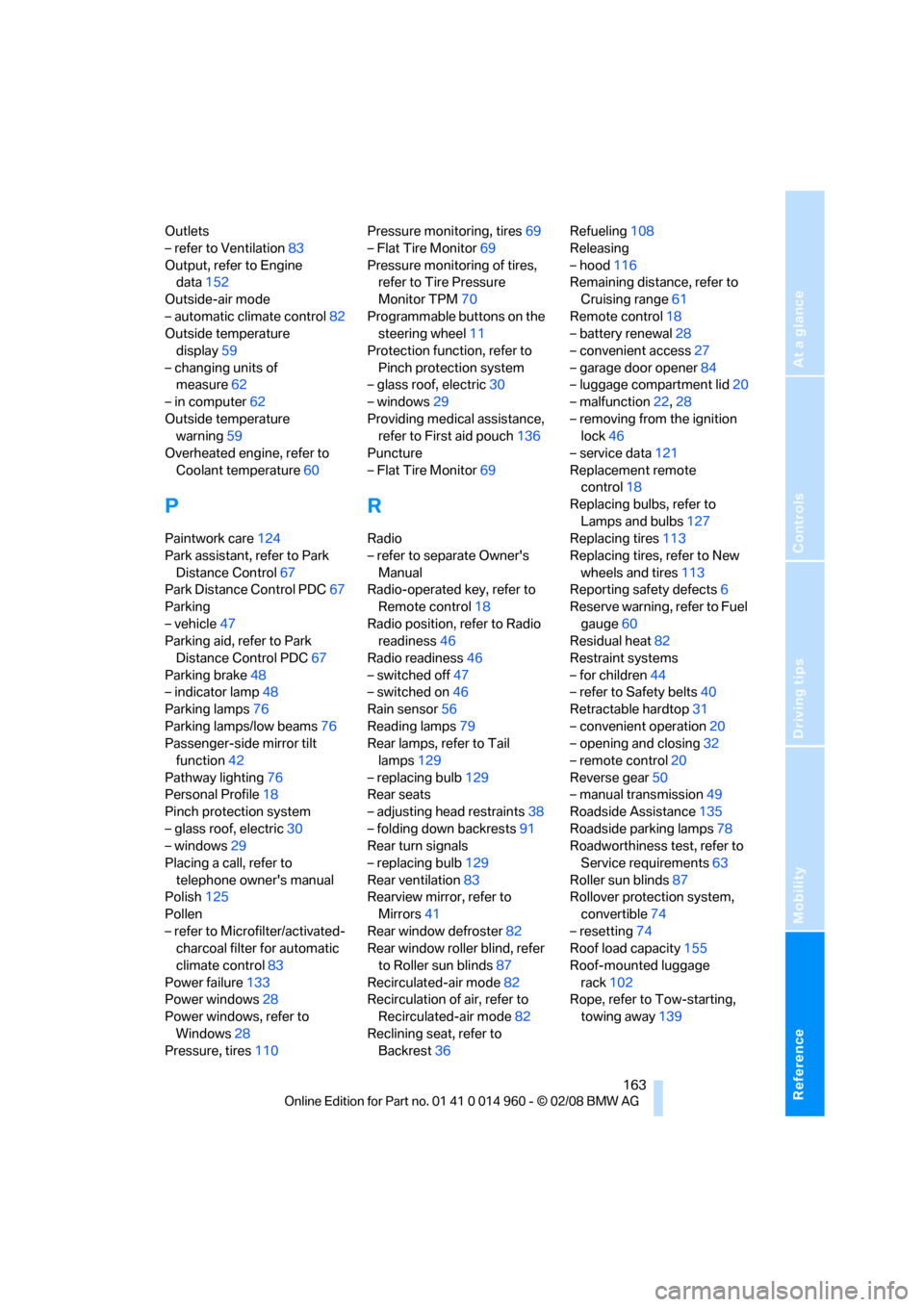
Reference
At a glance
Controls
Driving tips
Mobility
163
Outlets
– refer to Ventilation83
Output, refer to Engine
data152
Outside-air mode
– automatic climate control82
Outside temperature
display59
– changing units of
measure62
– in computer62
Outside temperature
warning59
Overheated engine, refer to
Coolant temperature60
P
Paintwork care124
Park assistant, refer to Park
Distance Control67
Park Distance Control PDC67
Parking
– vehicle47
Parking aid, refer to Park
Distance Control PDC67
Parking brake48
– indicator lamp48
Parking lamps76
Parking lamps/low beams76
Passenger-side mirror tilt
function42
Pathway lighting76
Personal Profile18
Pinch protection system
– glass roof, electric30
– windows29
Placing a call, refer to
telephone owner's manual
Polish125
Pollen
– refer to Microfilter/activated-
charcoal filter for automatic
climate control83
Power failure133
Power windows28
Power windows, refer to
Windows28
Pressure, tires110Pressure monitoring, tires69
– Flat Tire Monitor69
Pressure monitoring of tires,
refer to Tire Pressure
Monitor TPM70
Programmable buttons on the
steering wheel11
Protection function, refer to
Pinch protection system
– glass roof, electric30
– windows29
Providing medical assistance,
refer to First aid pouch136
Puncture
– Flat Tire Monitor69
R
Radio
– refer to separate Owner's
Manual
Radio-operated key, refer to
Remote control18
Radio position, refer to Radio
readiness46
Radio readiness46
– switched off47
– switched on46
Rain sensor56
Reading lamps79
Rear lamps, refer to Tail
lamps129
– replacing bulb129
Rear seats
– adjusting head restraints38
– folding down backrests91
Rear turn signals
– replacing bulb129
Rear ventilation83
Rearview mirror, refer to
Mirrors41
Rear window defroster82
Rear window roller blind, refer
to Roller sun blinds87
Recirculated-air mode82
Recirculation of air, refer to
Recirculated-air mode82
Reclining seat, refer to
Backrest36Refueling108
Releasing
– hood116
Remaining distance, refer to
Cruising range61
Remote control18
– battery renewal28
– convenient access27
– garage door opener84
– luggage compartment lid20
– malfunction22,28
– removing from the ignition
lock46
– service data121
Replacement remote
control18
Replacing bulbs, refer to
Lamps and bulbs127
Replacing tires113
Replacing tires, refer to New
wheels and tires113
Reporting safety defects6
Reserve warning, refer to Fuel
gauge60
Residual heat82
Restraint systems
– for children44
– refer to Safety belts40
Retractable hardtop31
– convenient operation
20
– opening and closing32
– remote control20
Reverse gear50
– manual transmission49
Roadside Assistance135
Roadside parking lamps78
Roadworthiness test, refer to
Service requirements63
Roller sun blinds87
Rollover protection system,
convertible74
– resetting74
Roof load capacity155
Roof-mounted luggage
rack102
Rope, refer to Tow-starting,
towing away139